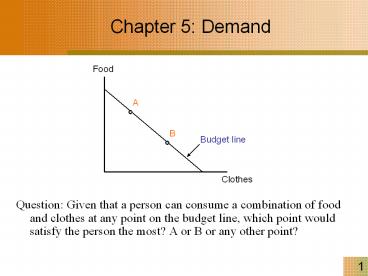Chapter 5: Demand PowerPoint PPT Presentation
Title: Chapter 5: Demand
1
Chapter 5 Demand
Food
A
B
Budget line
Clothes
- Question Given that a person can consume a
combination of food and clothes at any point on
the budget line, which point would satisfy the
person the most? A or B or any other point?
2
Demand
- People allocate their limited income among
different goods and services to maximize their
satisfaction. - Utility the satisfaction people derive from
consumption - Subjective
- Not comparable between people
- Individuals goal is to maximize their utility
- Revisit the cost-benefit principle
- People would consume one more unit of food only
if the marginal utility of doing so is at least
as large as its cost, which is the utility lost
from the reduction in the consumption of clothes.
3
Utility An Example
Sarah's Utility from Ice Cream
Cones / Hour 0 1 2 3 4 5 6
Total Utility 0 50 90 120 140 150 140
4
Utility An Example (Cont.)
Sarah's Marginal Utility from Ice Cream
Cones / Hour 0 1 2 3 4 5 6
Total Utility 0 50 90 120 140 150 140
Marginal Utility 50 40 30 20 10 -10
- Marginal utility the additional utility from
consuming one more
5
Diminishing Marginal Utility
As consumption increases beyond some point , the
marginal utility gained from consuming additional
unit of a good tends to decrease.
6
Marginal Utility
- Given a fixed income, how would a person choose
between two goods in order to maximize his/her
utility from consumption? - Compare the marginal utility gained from choosing
one good with the marginal utility lost from
giving up another good - Law of Diminishing Marginal Utility applies
- As you buy more of a single good, its marginal
utility decreases - When you buy less of that good, its marginal
utility increases
7
Utility Maximization An Example
Sarah's Ice Cream
- Buy 200 pints of vanilla and 100 pints of
chocolate - Marginal utility is 12 for vanilla, 16 for
chocolate
- 400 budget
- Chocolate is 2 per pint
- Vanilla is 1 per pint
Vanilla Ice Cream
MU (utils/ pint)
12
200
Pints/yr
8
Utility Maximization An Example
- Susan can increase her utility by consuming less
Chocolate and more Vanilla - Reduce one pint of chocolate saves her 2, with
which Susan can buy two more pints of vanilla (1
per pint) - Marginal utility lost from giving up one pint of
chocolate 16 utils - Marginal utility gained from two more pints of
vanilla 2x1224 utils - Gain gt Loss, Susan should buy more vanilla and
less chocolate - So, under what conditions would Susan maximizes
her total utility? In other words, what is the
optimal combination of chocolate and vanilla that
gratifies Susan the most?
9
Utility Maximization An Example
- Marginal utility of vanilla is 8
- Marginal utility of chocolate is 24
- Increase vanilla by 100
- Reduce chocolate by 50
10
Utility Maximization An Example
- Optimal combination highest total utility
- 250 pints vanilla 75 pints chocolate
- Marginal utility / price is the same for all
goods - Marginal utility of vanilla 10, chocolate 20
11
Utility Maximization An Example
Scenario 1 Price Quantity Marginal Utility MU /
Vanilla 1 200 12 12
Chocolate 2 100 16 8
Scenario 2 Price Quantity Marginal Utility MU /
Vanilla 1 300 8 8
Chocolate 2 50 24 12
Scenario 3 Price Quantity Marginal Utility MU /
Vanilla 1 250 10 10
Chocolate 2 75 20 10
12
Rational Spending Rule
The Rational Spending Rule Spending should be
allocated across goods so that the marginal
utility per dollar is the same for each good
MU1 / P1 MU2 / P2
13
Rational Spending Rule
- Substitution effect
- Suppose, one starts with MU1/P1MU2/ P2
- When P1 increases, MU1/P1ltMU2/ P2
- According to the rational spending rule, one
should increase spending on good 2 and reduce
spending on good 1 until MU1/P1MU2/ P2 again - So explained is the substitution effect.
14
Rational Spending Rule
Eric's Apples
Apples Oranges
Total Expenditures 100 50
Price 2 1
Total Utility 1,000 400
Quantity 50 50
- Is Eric following the Rational Spending Rule?
- What matters is the marginal utility in the
rational spending rule.
15
Individual and Market Demand Curves
- The market demand is the horizontal sum of
individual demand curves - At each possible price, add up the number of
units demanded by individuals to get the market
demand
16
Consumer Surplus
- Consumer's surplus is the difference between the
buyer's reservation price and the market price - If the market supplied only one unit, the maximum
price would be 11 - For the second unit, the price is 10, and so on
- The last buyer gets no consumer surplus
Vanilla Ice Cream
12
11
10
9
8
7
Marginal utility (utils/ pint)
6
5
4
3
2
D
1
2
4
6
8
10
12
Units/day
17
Consumer Surplus
- Market price is 6 for all sales
- Total consumer surplus
- The first sale generates 5 of consumer surplus
- Reservation price of 11 minus the price of 6
- Selling the second unit has 4 of consumer
surplus, and so on - Total consumer surplus is the area under the
demand curve and above market price
Vanilla Ice Cream
12
11
10
9
8
7
Marginal utility (utils/ pint)
6
5
4
3
2
D
1
2
4
6
8
10
12
Units/day
18
Consumer Surplus An Example
- Price is 2 and quantity is 4,000 gallons per day
- Consumer surplus is the area of the triangle
formed by - Demand curve
- Vertical axis
- Horizontal intercept of demand curve
- Remember area of a right triangle is ½ width
times height - The area is ½ (1)(4,000 gal) 2,000

